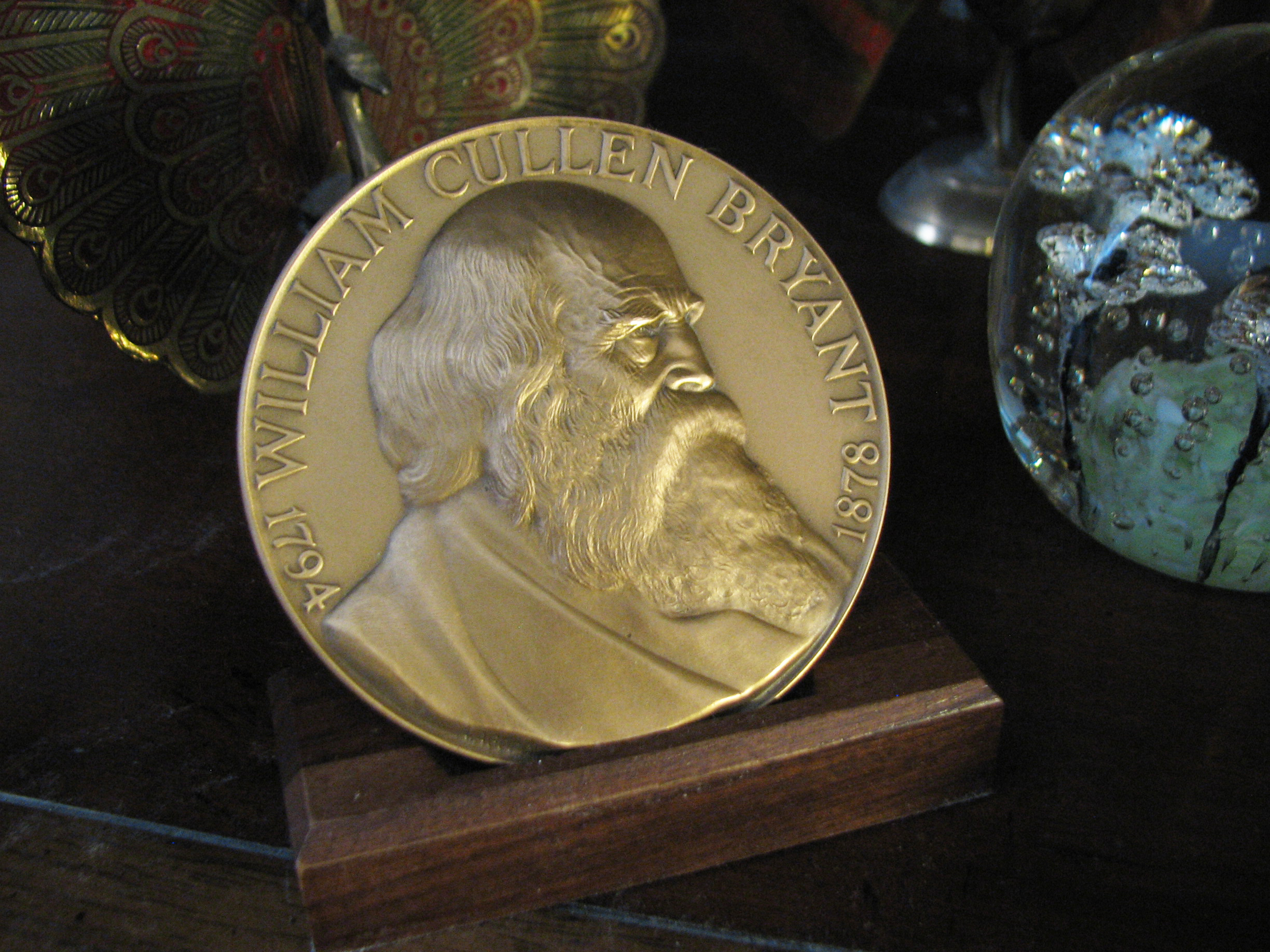
Thursday, March 1, 2018
Medal Featuring William Cullen Bryant
5:49pm
Meanwhile, I was curious to see a closer view of the Lake Placid medal. That didn't happen, but the search links led me to Ebay search results, in which other medals by Medallic Art Co. were for sale. I was impressed with the artwork for the Bryant medal, and went to learn more about Bryant.
William Cullen Bryant, 1794-1878, was a poet, and editor of the New York Evening Post. He first started out as an attorney, but hated it. So he headed to New York City, and with some help from "a distinguished and well-connected literary family"(Wikipedia), he soon got an editorial position which eventually led to his position of fifty years with the Evening Post.
Although Bryant was a descendant of Puritan immigrants, he later "rejected Puritan dogma for Deism; thereafter he was a Unitarian."(Britannica) In fact, he was "a hymnist for the Unitarian Church"(Wikipedia). Although I checked the Unitarian Universalist hymnal that's used today, and failed to find any by him, hymnary.org lists twenty five of his hymns.
Wikipedia mentions an interesting fact:
"He was also a nephew of Charity Bryant, a Vermont seamstress who is the subject of Rachel Hope Cleves's 2014 book Charity and Sylvia: A Same-Sex Marriage in Early America.[3] William Cullen Bryant described their relationship: "If I were permitted to draw the veil of private life, I would briefly give you the singular, and to me interesting, story of two maiden ladies who dwell in this valley. I would tell you how, in their youthful days, they took each other as companions for life, and how this union, no less sacred to them than the tie of marriage, has subsisted, in uninterrupted harmony, for more than forty years." Charity and Sylvia Drake are buried together at Weybridge Hill Cemetery, Weybridge, Vermont."
In addition to these other similarities, Julia did some genealogical research, and (of course!) she is related to him. Furthermore, he named one of his two daughters Julia! Small world!
I'm quite sure his Ka (soul) would be glad that his medal ended up in a prominent place on our living room bookshelves.
Now, let's look at the back side of the medal:
 The seated lady looks out on the horizon, and the text says: How glorious, through his depths of light, Rolls the majestic sun! |
Those words come from a poem of Bryant's, The Artic Lover.
What about the other text on this side, "The Hall of Fame for Great Americans at New York University"? New York University found itself in hard financial times and sold this part of their university in 1972, so the Hall of Fame is now at Bronx Community College. It was designed by architect Stanford White, in a Greco-Roman style, and houses ninety eight bronze portrait busts.
The medals came later. D. Wayne Johnson explains:
"Over the next 13 years, 96 medals were created by 42 sculptors, predominately members of the National Sculpture Society. While the design was left to the artist each submission had to pass the approval of the Art Committee composed of at least five of the artists’ sculptural peers.
"Rules for the medal design were simple. It had to be a portrait on the obverse, significant scene from that subject’s accomplishment for the reverse plus lettering on either side, in legend or inscription, HALL OF FAME FOR GREAT AMERICANS AT NEW YORK UNIVERSITY.
"Medals were struck in two sizes. A large 3-inch (76mm) bronze only, and a small 1¾-inch (44mm) size in bronze and silver. The silver medals were serially numbered." https://medalblog.wordpress.com/2012/12/03/hall-of-fame-series-the-most-successful-medal-program/
I have the three inch version, which is the same size as my Hathor-Sekhmet medal. I used one of the stands which came with my box of medals to serve as a stand for Bryant's medal. Of course, it is a perfect fit!
Medal collectors website names the artist of each medal. Agop Agopoff did Bryant's fine portraiture. Agop Minass Agopoff was born on May 15, 1905 in Silven, Bulgaria.
He immigrated to the States in 1929 and died in Denville, New Jersey in 1983. Medalartists.com gives a fairly extensive history of Agopoff. Numismatics.org gives more examples of his art. One of Agopoff's major pieces is a large relief of John F. Kennedy Memorial at Hyannis Port, Massachusetts.
Based on the success of other medal campaigns, about U.S. Presidents and U.S. states, Medallic Art's president "formed a coalition to sponsor and market fine art medals of these most famous Hall of Fame Americans."
